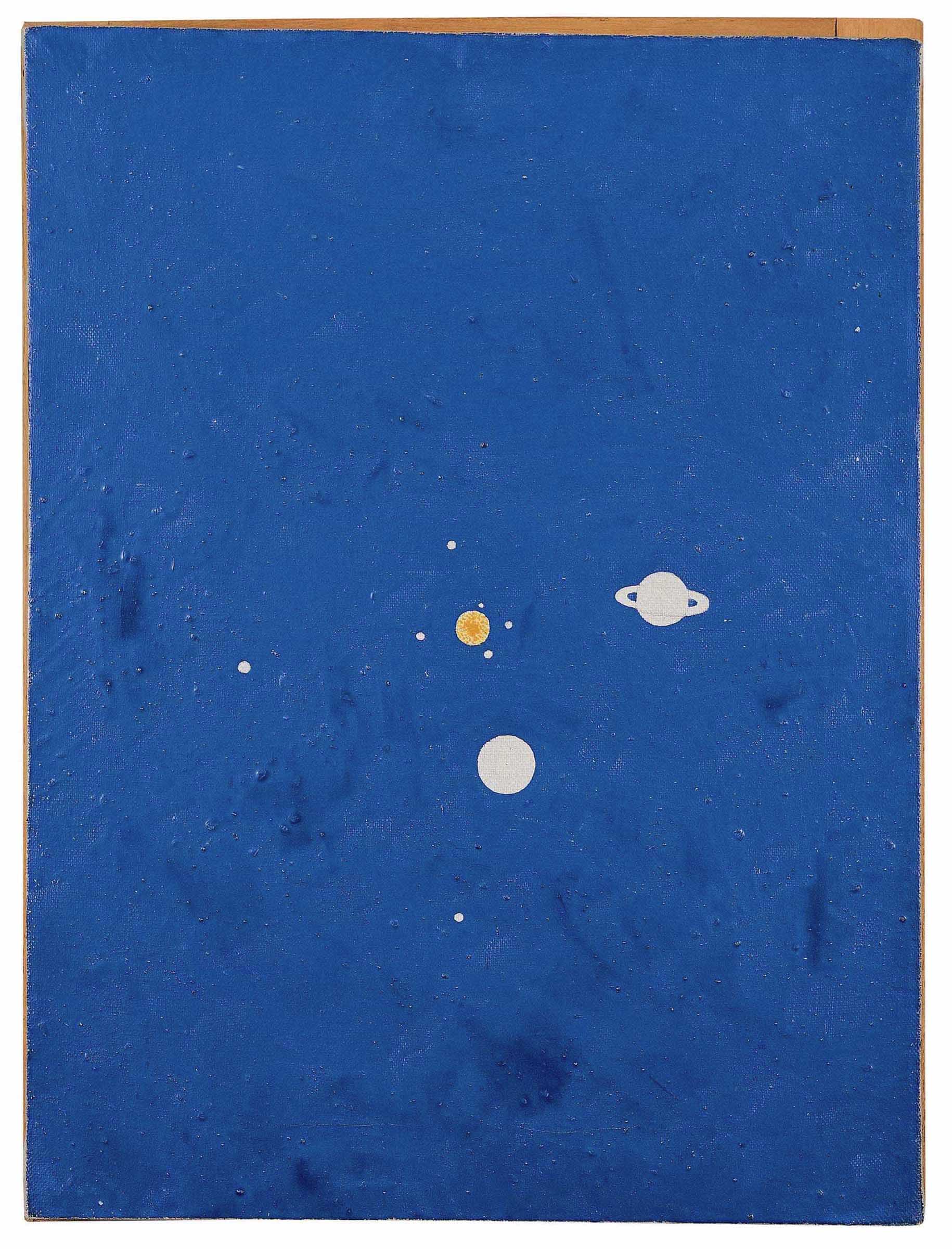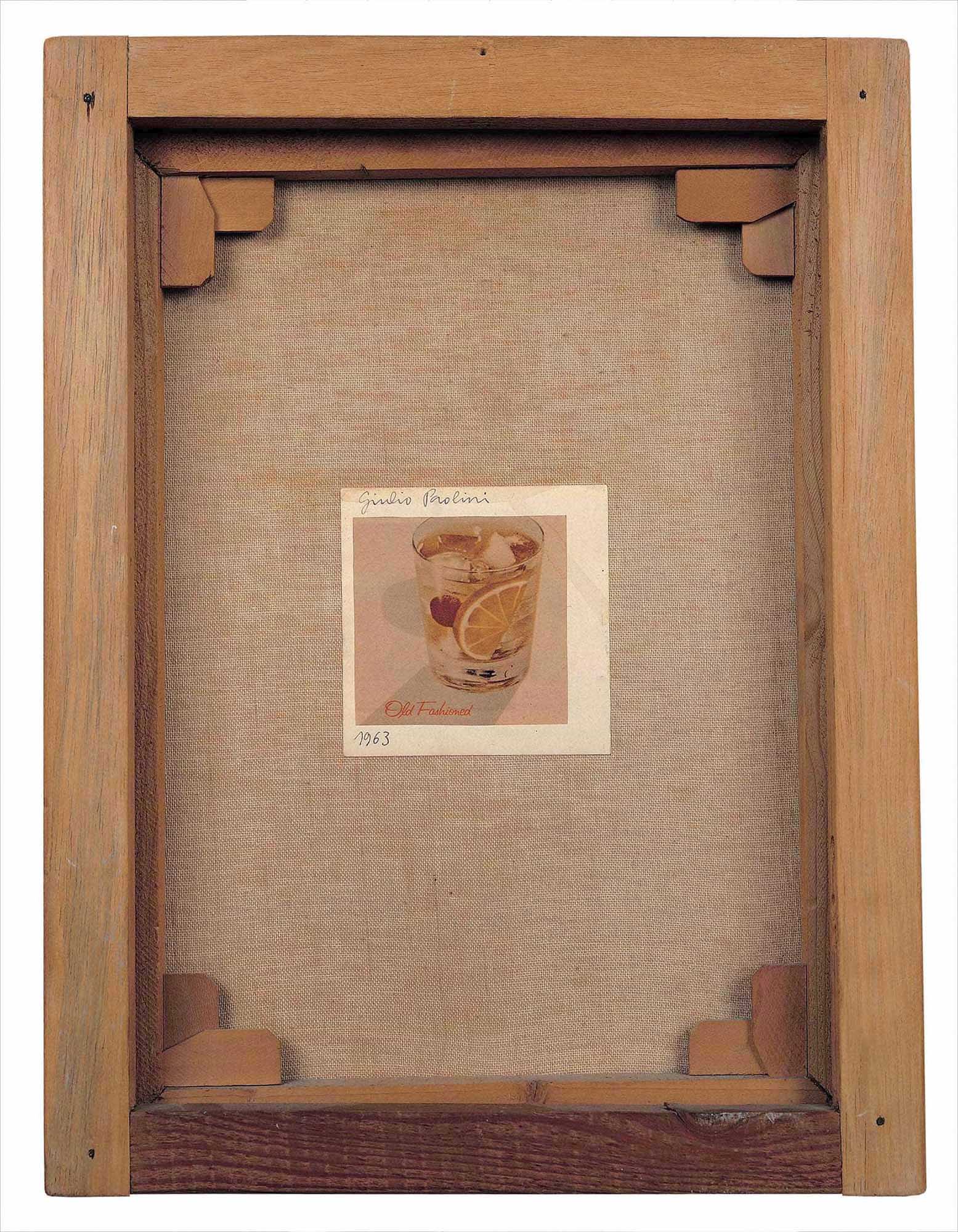Old fashioned, 1963
GPO-0045
Oil on canvas mounted on a stretcher
40 x 30 cm
Signed and dated on the verso on a white paper square: “Giulio Paolini” (upper left), “1963” (lower left)
Private collection, Turin
A canvas depicting the solar system is mounted on a stretcher that is just slightly larger; moreover, the adhesives on the verso make the canvas protrudes slightly from the stretcher. The Sun painted by the artist with the colour orange, in a central position, stands out against the blue background, while the other planets, isolated in negative, reveal the unprimed canvas. On the back is an image from an advert for a cocktail accompanied by the name "Old Fashioned". Old Fashioned is part of a group of works (from GPO-0028 to GPO-0049) whose common denominator is the presence of an intervention on both the recto and the verso of the painting. Surfaces of various types take turns appearing on the recto (painted paper, graph paper, photographic reproductions, shaped wooden panels), while on the verso (hidden from view) we find the details of images and printed words taken from magazines or from books. The title, when specified, refers to a textual element present on the verso. The artist explains that: “Just as on the surface various elements alternate among themselves, but always remain ‘blind’, in the sense that they tend not to supply an image, but are there for their own sake, occupying that given space, so the title itself is absolutely autonomous with respect to the surface [...], constituted by a fragment of words and, at times, images, following the signature and the date, on a white paper square on the back of the picture” (1972).1
With respect to the variant made during the same year entitled Un’offerta speciale (GPO-0044), the painted canvas is distinguished by its smaller size and the different shade of blue.
1 G. Paolini in G. Celant, Giulio Paolini (New York: Sonnabend Press, 1972), p. 34 (revised translation, republished in Giulio Paolini 1960-1972, edited by G. Celant [Milan: Fondazione Prada, 2003], p. 122) reprint (Cinisello Balsamo: Silvana Editoriale, 2019), p. 34. Cf. also the artist's remarks in C. Lonzi, Autoritratto (Bari: De Donato Editore, 1969), p. 367, reprint (Milan: Et al./Edizioni, 2010), p. 280, English edition (Brussels-London: Divided Publishing, 2021), p. 320.
| • | G. Paolini in G. Celant, Giulio Paolini (New York: Sonnabend Press, 1972), pp. 30-31; republished in Giulio Paolini 1960-1972, edited by G. Celant (Milan: Fondazione Prada, 2003), p. 122; reprint (Cinisello Balsamo: Silvana Editoriale, 2019). |
| • | M. Disch, Giulio Paolini. Catalogo ragionato 1960-1999, vol. 1 (Milan: Skira editore, 2008), cat. no. 45 p. 79, col. repr. (recto and verso). |
| • | E. Volpato, “Iconografie della malinconia”, in Collezioni. Volume terzo: Allestimento 2011-2013, edited by D. Eccher (Turin: GAM Galleria Civica d’Arte Moderna e Contemporanea and Umberto Allemandi & C., 2012), p. 210, repr. p. 208. |
| • | D. Soutif, “Filigrane. Paolini, il primo quadro e la storia dell’arte”, in S. Bann et al., Il passato al presente. In tema 2 (Turin-Mantua: Fondazione Giulio e Anna Paolini and Corraini Edizioni, 2016), p. 94, not repr.; republished in French in Les Cahiers du Musée national d’art moderne 137 (Paris), Autumn, 2016, p. 80, not repr. |



